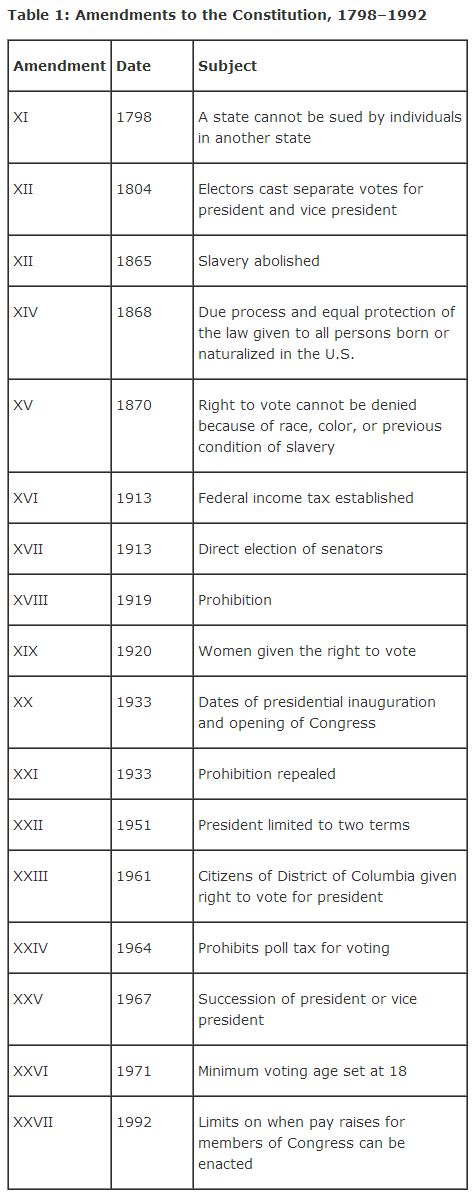The Amendment Process and Bill of Rights
The Constitution (Article V) provides that amendments can be
proposed either by Congress, with a two-thirds vote of both houses, or by a
national convention requested by two-thirds of the state legislatures.
Amendments are ratified by three-fourths of the state legislatures or by
conventions in three-fourths of the states. Only the Twenty-first Amendment,
which repealed Prohibition in 1933, was adopted by state conventions.
The Bill of Rights
Congress proposed 12 amendments in September 1789; three-fourths of the states approved ten of them in December 1791, creating the Bill of Rights. The following list summarizes the Bill of Rights:
- Prohibits the establishment of a state religion and protects freedom of the press and speech and the rights to assemble and petition the government (Amendment I)
- Guarantees the right to keep and bear arms in the context of a state militia (Amendment II)
- Prohibits the stationing of troops in homes without consent (Amendment III)
- Protects against unreasonable searches and seizures and requires probable cause for search warrants (Amendment IV)
- Establishes a grand jury to bring indictments in capital or serious cases, protects against double jeopardy (a person cannot be tried twice for the same crime) and self-incrimination (individuals cannot be forced to testify against themselves), and guarantees due process and eminent domain (compensation must be paid for private property taken for public use) (Amendment V)
- Guarantees the right to a speedy trial by an impartial jury in criminal cases, to be informed about charges, and to have representation by counsel (Amendment VI)
- Provides for trial by jury in most civil cases (Amendment VII)
- Prohibits excessive bail or fines and cruel and unusual punishments (Amendment VIII)
- Does not deny people any rights not specifically mentioned in the Constitution (Amendment IX)
- Gives to the states or the people powers not granted to Congress or denied to the states (Amendment X)
Subsequent amendments to the Constitution
Since the enactment of the Bill of Rights, the amendment process has been used sparingly. While numerous amendments have been proposed in Congress, only a handful have gone to the states for action. An additional 17 amendments to the Constitution have been ratified over the last 200 years; six proposals failed to win enough support — most recently, the Equal Rights Amendment, strongly backed by women's groups, and an amendment to give the District of Columbia full representation in Congress. The country has used the amendment process once to promote a particular social policy; Amendment XVIII (1919) prohibited the manufacture and sale of intoxicating liquors but was repealed in 1933 (Amendment XXI). The other amendments either address how the government operates or expand equality. Table 1 provides a brief summary of the amendments added to the Constitution since the enactment of the Bill of Rights.
